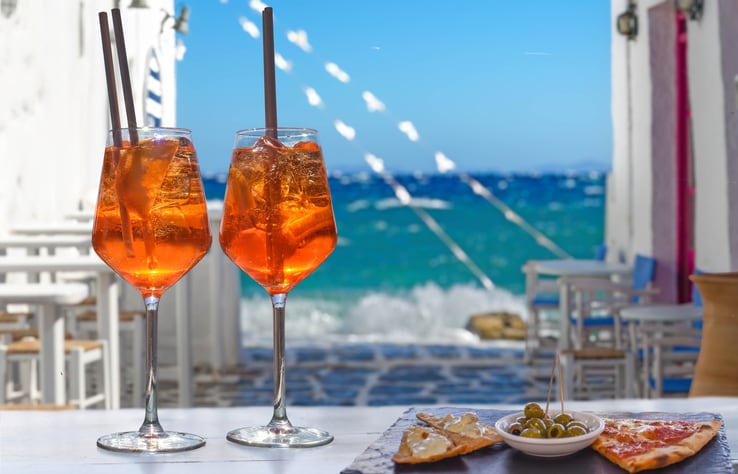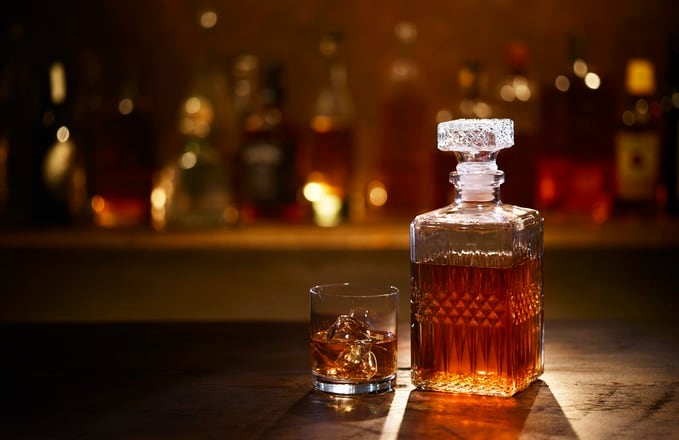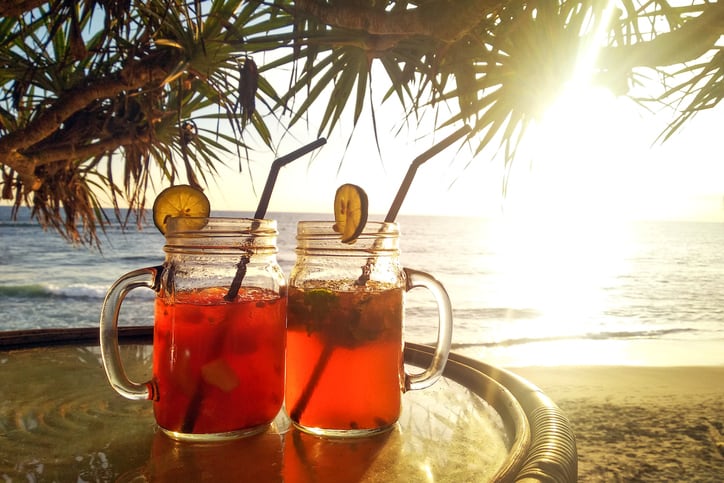Now a summer favorite the world over, the spritz generally combines Prosecco (or another sparkling wine) with a liqueur and a splash of soda water.
Drawing on European aperitivo culture – where the spritz can frequently be found on sunny terraces after work – it has also found fame in the US and UK as a light, easygoing summer drink.
And now the spritz is evolving: whether that’s with a Campari spritz (a drink with an extra bitter punch); Venetian spritz (an Aperol spritz with a twist) limoncello spritz (with a lemon twist) or Hugo spritz (a flowery elderflower take).
In many ways, the popularity of the spritz serves as a perfect illustration to today’s top trends.
It’s colorful and easy to glam-up: great for Instagram or other social media platforms. It’s a relatively simple drink to make, yet feels like a real treat on a Friday evening. It’s easy to turn a spritz into a lower alcohol or alcohol-free version: with sessionability in mind over the high ABV of other cocktails.
Spritz deliver a flavor punch that goes beyond sweet. And the opportunities for innovation are almost endless: experimenting with different liqueurs and the flavors and hues they provide.
And, like the sparkle the spritz gives consumers, the demand for the base aperitif liqueur is giving spirits companies a bright spot in an otherwise tricky spirits market.
Campari’s classic: Aperol
The Aperol spritz has established itself as the go-to classic: a light, slightly bitter spritz with a vibrant orange color.

It’s been a huge success story for Aperol brand owner Campari. Aperol consumption has exploded since 2019 and the company has taken this European favorite – drawing on both a sophisticated continental vibe as well as fun loving, distinctive orange branding – around the globe.
Campari bought the Aperol brand in 2003 when it was an Italian specialty: today, it’s a global favorite.
“We took the brand in house when it was less than 50,000 cases: now it’s the dominant brand that’s really been the force behind the building of a whole spritz category in the US,” Melanie Batchelor, Campari America’s managing director, told us.
“It’s an amazing product. The Aperol spritz is a refreshing cocktail, and it plays into a lot of trends that we were starting to see bubble up, low alcohol cocktails, for example.
“But we’d also seen the success of the brand in many countries – primarily Italy – and so we had an idea from the playbook of how to build this brand, which is really based on experiential: giving consumers the opportunity to try it.
“And back when we started investing in it, we saw the opportunity with Instagram and influencers given how beautiful the product is.”
The Aperol brand – once an interesting bet for the company as a lighter alternative to Campari – is now the group’s biggest and most successful brand (making up 24% of the company’s portfolio compared to 11% for Campari).
The brand grew 11% in the US in 2024, despite the competitive landscape and broader economic headwinds that are hitting the alcohol category.
“The key to Aperol Spritz’ success lies in how it creates moments of joyful consumption – whether at iconic events like Coachella and the US Open or more casual, everyday social settings,” added Allison Varone, head of marketing at Campari America.
“While Aperol has been leading the spritz phenomenon over the past few years, we are seeing consumers who also enjoy a more bitter profile adopt the Campari Spritz as well.”
Putting some spritz into sales
Volumes of premium-priced bitters/spirit aperitifs have surged in the US, with CAGR growth of +18% between 2018 and 2023, according to IWSR. This momentum is expected to accelerate in the years ahead, with +19% CAGR growth forecast for 2023-28 according to IWSR forecasts.
Campari believes there’s plenty more room for growth for both Aperol to grow across the US and wider afield.
And there’s also a key opportunity to broaden drinking occasions. Still primarily enjoyed as a summer drink, Aperol’s big challenge (and big opportunity) is to keep the drink relevant year round.
In fact, this year its marketing team put its muscle into the ski season: with the Aperol Apres Ski Collection (featuring items like beanies, thermal sets, hoodies, sweaters and more) and Apres Ski events at Aspen, Colorado.
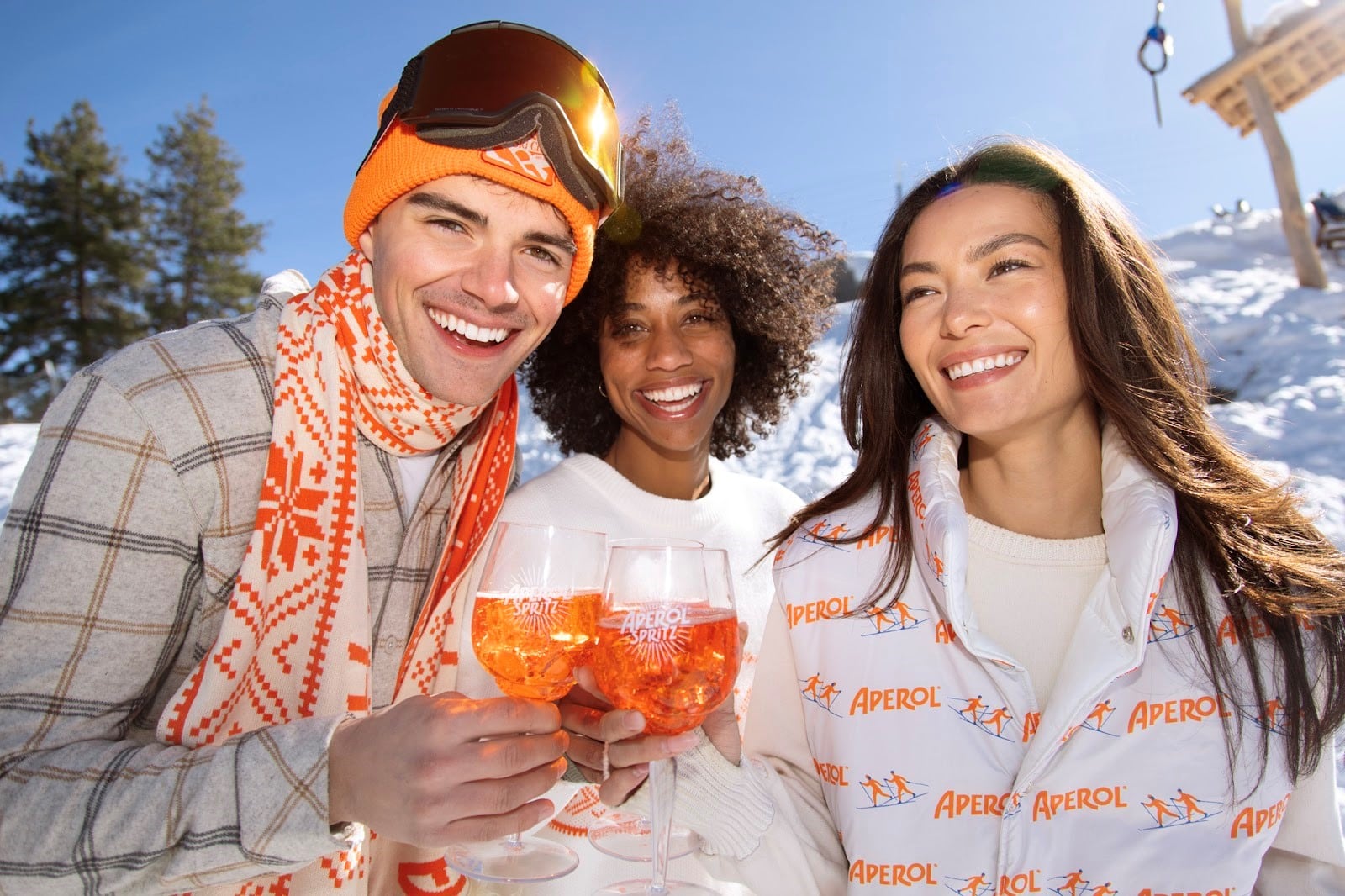
Bacardi: Elderflower flourish
Also embracing spritz’ potential is Bacardi with St-Germain: an elderflower liqueur that adds a flowery flourish to the spritz.
It’s another brand that has seen impressive growth.
“The brand has seen 31% year-over-year growth, well ahead of the overall Spritz category, which is up 14% globally,” said Emma Fox, Global VP St-Germain & Martini.
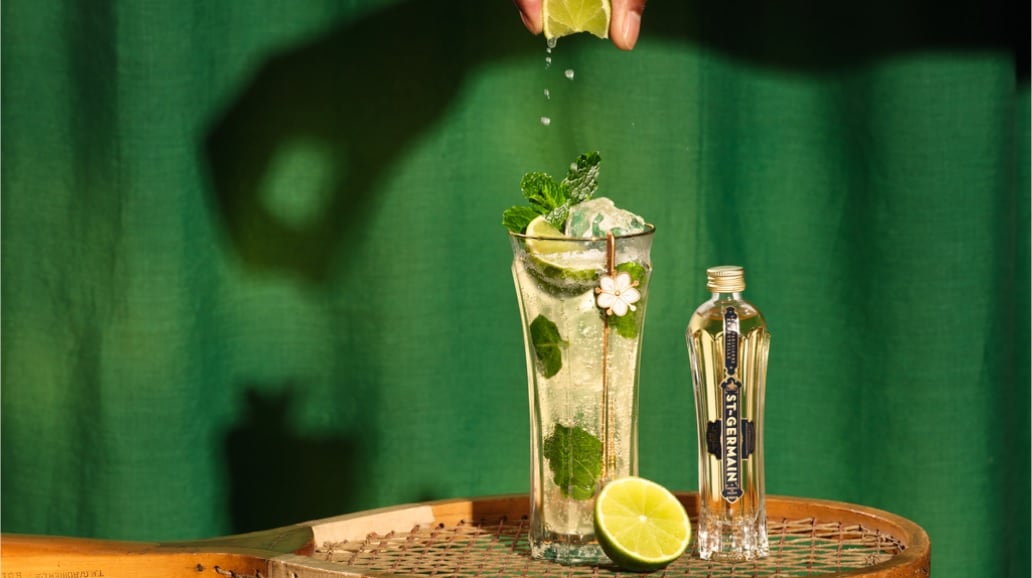
“Its lighter, fresher, brighter character appeals to a growing audience looking for more refined and flavorful low-ABV choices.
“Since 2019, St-Germain’s global market share has nearly tripled, reflecting strong and sustained demand.”
For Fox, the popularity of the spritz is easy to explain.
“Consumers are increasingly drawn to drinks that are lighter in both alcohol and flavor, yet still feel premium and suited to the occasion,” she said. “The spritz meets that demand with a refreshing, approachable profile that invites creativity without complexity.”
“And the spritz aligns perfectly with evolving lifestyle preferences around moderation and natural ingredients. Lower alcohol, high refreshment, and visual appeal make it ideal for daytime and social occasions.”
Puttin' on the spritz: Who's drinking what and when?
Bacardi has done plenty of research into cocktail trends, as well as delving more specifically into the spritz category
“For the key spritz audience, we know that, globally, 25–45-year-olds account for ~60% of the aperitivo category penetration (Tempo Bacardi),” said Fox.
“The majority of aperitivo and spritz occasions are happening in the on-trade, with 37% taking place in casual out-of-home settings like after-work drinks or sunny afternoon socials, and 30% for special ones. This growth is driven by younger consumers who are redefining how and when they socialise, leaning into daytime and early evening drinking occasions.
“In Europe, we’ve even seen that the spritz is overtaking Champagne as the go-to drink for socialising, with the Bacardi Global Consumer Survey revealing it’s the top choice for 41% of respondents. In the UK, Gen Z and younger consumers (18–29) are showing a clear shift toward cocktails. 35% of consumers prefer them to beer, and one in four choose them over wine, reflecting a wider move toward spritz-style serves (Bacardi Cocktail Trends Report 2025 ).
The spritz springboard
So what’s next for the spritz category? Experimenting with different liqueurs (limoncello, St-Germain and more) is already a top trend. But where else can the category go?
For Campari, one bet is on the US debut of Crodino this year: a non-alcoholic aperitif that could follow Aperol’s trajectory from small Italian favorite to American superstar.
For Campari, this taps into a clear trend of moderation that’s being seen the world over.
“As demand for premium non-alcoholic options continues to rise, especially among younger consumers, Crodino is well positioned to meet this moment,” said Varone.
“It delivers the same complexity and bitter-forward flavor that defines traditional aperitifs, but in a fully non-alcoholic format, making it ideal for summer social occasions where moderation is top of mind.
“What makes Crodino so timely is its alignment with several major trends for summer 2025: from the growth of mindful drinking and low-ABV lifestyles, to the continued dominance of spritz culture, and an appetite for authentic, globally inspired experiences."

Another evolving area for spritz is the wine route. A wine spritz is a light, refreshing cocktail made by combining wine, typically white or rose, with sparking water, soda or a flavored mixer.
It’s often served over ice with a citrus garnish: making it a go-to for warm weather and casual occasions.
The wine category has already benefited from the spritz trend (Italian sparkling wine volumes in the US grew at a CAGR of +5% between 2018 and 2023, and are set to expand at a CAGR of +4% between 2023 and 2028: partly attributed to the spritz craze, says IWSR).
But it’s a great way for the wine category to modernize and find a new audience: again bucking trends in a struggling category.
“What makes a spritz so appealing is its versatility and lower ABV, offering consumers a more sessionable option that still delivers on flavor and style,” said Zach Poelma, senior vice president, supplier strategy and insights at US distributor Southern Glazer’s Wine & Spirits.
“While white and rosé wines are the most common base, innovative red wine spritzes are emerging, especially when balanced with bright, effervescent mixers.
“Wine spritzes represent a powerful growth opportunity, especially as consumers seek out lighter, more approachable formats. They resonate with younger drinkers who value moderation, customization, and fun.
“As spirit-based spritzes like the Aperol Spritz surge in popularity, wine-based versions are a natural evolution, bridging the gap between wine tradition and modern cocktail culture.”

